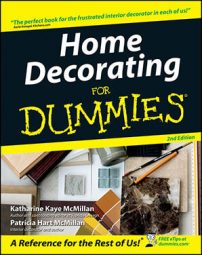Historic patterns reappear from year to year in fresh, new combinations of colors. Color and scale affect a pattern, making it more or less formal. Some historic patterns, originally seen in monochromatic colorways, look very different in multicolors. Some perennial favorite patterns are listed here. Keep in mind that many appear on materials other than textiles:
Calico: This cotton fabric is printed with small, brightly colored floral patterns. Cheerful and modest, calico creates a cozy feeling that is a big part of Country-style decorating. This pattern also shows up in china.
Chintz: This cotton fabric features generously scaled floral arrangements and comes in many colors. It’s typically found in traditional English styles. Glazing (a shiny coating) gives it extra pizazz. So do the ribbon-and-flowers patterns that the French add, and broad stripes that seem so typical of English homes.
Flame stitch: A pattern that looks like flickering flames, flame stitch is multicolored and, when woven, very textural. You often notice flame stitch with 18th-century furniture. Somewhat masculine in character, it’s at home in traditional settings but looks great as an accent in a contemporary room.
Gingham: This pattern consists of two color checks (blue and white, red and white, yellow and white), usually in a woven cotton fabric. It almost epitomizes humble Country styles. But, a silk gingham, especially in large over-scale checks, acquires an elegance that is at home in any villa or town house.
Herringbone: The diagonal ridge that reverses direction periodically in this weave creates a vertical stripe effect. Some people think it looks like a fish skeleton, which is how it earned its name. Herringbone is most often seen in vinyl wall covering replications, especially in commercial interiors. It’s tailored and masculine in character.
Stripes: Stripes are, obviously, repeated vertical lines, but keep in mind that stripes come in many different varieties, including the following:
Awning stripes: Big, broad, monochromatic stripes used for awnings, found in upholstery and wall coverings
Rep (or irregular) stripes: Alternating narrow and wide stripes, often in woven silk fabrics used for upholstering Traditional-style chairs
Roman stripes: Stripes in alternating bright colors and sometimes of varying widths, found in silk and synthetic fabrics for curtains and upholstery in traditional-style rooms
Satin stripes: Alternating matte (dull) and satin (shiny) stripes in silk and silk-like synthetic fabrics (and wall coverings), appropriate for traditional rooms
Ticking stripes: Narrow, monochromatic stripes, most often in cotton fabrics used on pillows, but a favorite slipcover fabric for all kinds of country-style rooms from cottage to Sun Country style
Toile du Jouy: This line drawing of a pastoral scene in a single color appears on plain-woven cotton fabric. Designers strongly identify but do not limit toile du Jouy with French furnishings. You can use it in every room in any house.
Tree of Life: An ancient Oriental rendering of a sprawling tree, this pattern often also includes other plants and animals. You often notice the tree of life in 18th-century printed fabrics and wall coverings. It also seems very much at home in formal and dressy living rooms, dining rooms, and bedrooms.
Trellis: Garden trellises (narrow strips of wood lath joined either in a square or diamond pattern) are the basis of patterns often repeated on fabrics, wall coverings, and area rugs with and without accompanying flowers and vines. They add a sense of spatial depth, which provides a three-dimensional space-making effect that’s very liberating. This pattern is appropriate in any style of room.

